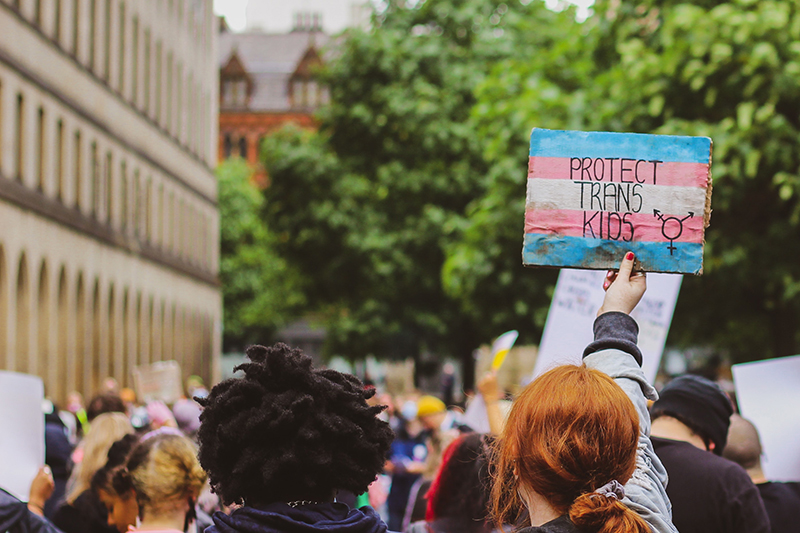Over the past decade, transgender and non-binary people have become more and more visible. But running alongside this increasing visibility has been an increasing current of anxiety. Much of this anxiety has focused on the figure of the trans child. What we don’t often hear is the voices of trans children and young people themselves.
At the end of 2020, a year when the covid-19 pandemic disrupted young people’s lives across the world, Elliot Page, star most recently of Umbrella Academy, came out as transgender at the age of 33. The same day, the High Court of Justice gave its judgement in Tavistock v Bell, a case that would drastically affect trans young people’s health, wellbeing and rights.
 Elliot Page: ‘I love that I am trans. And I love that I am queer.’
Elliot Page: ‘I love that I am trans. And I love that I am queer.’
Tavistock v Bell: a blow for trans young people's rights
On one side were the Tavistock Clinic and the NHS Portland Trust, which operate the NHS Gender Identity Development Service (GIDS) – the only specialist NHS clinic in the UK to provide medical care for children and young people experiencing distress relating to their gender identity. On the other side were Keira Bell, a 23-year-old woman who was prescribed puberty blockers at the age of 16 when identifying as a trans boy, and has since detransitioned, and Mrs A, the parent of an anonymous trans 15-year-old.
The case revolved around access to puberty blockers, a treatment that delays the onset of puberty, so that children don’t develop secondary sexual characteristics (such as breasts, facial hair or deepening voice) that conflict with their gender identity and cannot later be altered. Puberty blockers are a reversible treatment and have been used to delay early puberty for cis (non-transgender) children since the 1980s. International standards of treatment for gender dysphoria recommend puberty blockers as an appropriate treatment for under-18s diagnosed with gender dysphoria. If they choose, after the age of 16, trans young people may then go on to access cross-sex hormones, allowing them to develop secondary sexual characteristics corresponding to their gender identity. Lawyers for Bell and Mrs A argued that children could not consent to puberty blockers, because most children prescribed puberty blockers later go on to take hormones, which can have irreversible effects. No evidence was allowed from trans young people, their parents, or support organisations.

This decision strikes at the heart of bodily autonomy and children’s rights, not only for trans people but for all children and young people. The United Nations Convention on the Rights of the Child is one of the most universally accepted human rights treaties in history. It’s been ratified by the UK along with all other countries in the world, apart from the USA. Article 12 enshrines the rights of every child to express their views, feelings and wishes in any matters affecting them – and to have these taken seriously.
These rights are enshrined in the concept of ‘Gillick competence’ in English and Welsh law. In medical contexts, a child under the age of 16 can consent to medical treatment if they have ‘sufficient understanding and intelligence’. Gillick competence came about through a case about whether teenagers should be allowed access to contraception even without their parents’ consent. It protects young people’s rights to decide what happens to their own bodies, especially to their own reproductive decisions – especially vital for children living in abusive family situations. It is notable that the lawyers representing Keira Bell and Mrs A have also been involved in a number of cases challenging abortion rights. The Tavistock decision (which is currently being appealed) essentially makes Gillick competence impossible for trans young people. It says that they are incapable of making choices about their own bodies and futures.
Changing ideas of gender diversity
Those concerned about Tavistock point to a steep rise in the number of children being referred for gender identity treatment, arguing that children and young people are being misled or coerced into a trans identity. The number of referrals certainly has risen significantly, although the total number is still extremely small. In 2019-20, 161 under-18s were prescribed puberty blockers for gender dysphoria (0.01% of UK children) – three times as many newspaper articles about trans children were published in the national press in the same period.

However, there’s a strong argument that this increase comes from better awareness and acceptance of trans identity among children and parents. We can make an analogy to being left-handed, which used to be strongly socially stigmatised. Children were once punished for using their left hand to write. The percentage of left-handed people in the USA has grown from around 2-3% at the start of the 20th century, to around 12% today. Handedness is known to be substantially genetically inherited, and there is no evidence that any genetic shift happened over this time. But attitudes did shift: social acceptance of left-handedness increased.
Gender is not as simple as being left- or right-handed. Many aspects of being a man, or being a woman, are influenced by social expectations, and children learn and internalise these as they grow up. Some people feel quite comfortable in their expected gender roles, while others feel comfortable in some aspects of their gender, but uncomfortable in others. Exactly what those gender roles are, and how they’re expressed, has changed over time and will change again in the future. What we see as acceptable for men and women in the UK now is different from even ten or twenty years ago, and it’s different in different places.
Evidence from research with young children shows that from a young age, children who don’t conform to what’s expected from their gender are often socially excluded in obvious or subtle ways. Children learn early to alter aspects of their behaviour to fit into their expected gender roles (Callahan and Nicholas, 2019; Renold, 2005). Even under these pressures, a small percentage of people have always felt that they don’t fit within the expectations for their assigned sex, and have opted to live in ways that cross or dispense with the gender divide. Jules Gill-Peterson has shown how trans children existed and were the subjects of medical attention throughout the 20th century (Gill-Peterson, 2018). In the past, many young children and young people who felt deep discomfort or distress about the sex they were assigned at birth, or felt a strong desire to be another gender, might have suppressed their feelings. But with greater knowledge and understanding of options for transitioning gender, or living as non-binary, more children can explore different possibilities.
Navigating healthcare as a young trans or non-binary person
Unfortunately, the healthcare and support available to young trans, non-binary and gender non-conforming children and young people in the UK is lacking. The rapidly increasing numbers of referrals to GIDS mean that young people may wait two years for a first appointment after being referred. That often means going through puberty, causing greater distress as trans young people go through physical changes associated with their birth sex. Trans young people experience many more mental health issues than others, and are at a higher risk of self-harm and suicide.
Trans young people (and their parents) report the wearying obstacles of navigating the healthcare system (Carlile et al., 2021). Many GPs refuse to refer children for specialist treatment, or to administer prescribed medication. Referral letters go awry. Even after a first appointment, children can wait months to be assessed and start receiving any medical treatment. Professionals often have rigid, binary notions of gender that mean young people need to perform a stereotypical version of themselves. For example, Kieran, a 16-old-boy in Carlile’s study, was a keen ballet dancer. His CAMHS (Child and Adolescent Mental Health Services) therapist used this interest in ballet to question whether his desire to transition to male was genuine – he was expected to fit into a traditional, restricted form of masculinity in order to pass the gatekeeping of the gender identity development services. Other young people talked about the disconnect between their internal identity and the identity that professionals were looking for. Although they felt more comfortable with a fluid or non-binary identity, they felt they had to fit into a clear traditional gender category of male or female to access care.
Receiving substandard healthcare is distressing. But equally important is the joy and freedom young people experience after finally receiving gender-affirming care. Alice spoke about the calming effect of puberty blockers – giving her ‘the ability to halt puberty and be able to think about, you know, do I want surgery? Do I want hormones? Is this right? And not have the pressure of making a decision.’ One parent said ‘it was like my kid came back overnight.’ (Carlile, 2021)

A wide range of research has reported the positive impact of supportive, gender-affirming care for trans and gender-diverse young people. Young trans people who are supported to transition socially (for example, being referred to using their chosen names and pronouns and allowed to use the facilities associated with their gender) show rates of mental health issues similar to those of cis (non-transgender) young people (Olson et al., 2016). This suggests that social stigma and discrimination are the greatest contributors to poor mental health – not that being trans is in itself a sign of poor mental health.
Even before Tavistock v Bell, the current model of care for gender questioning young people in the UK has been criticised. Following an inspection late in 2020, the independent regulator of health and social care in England, said that services and waiting times at the GIDS needed significant improvement. Clearly, the model where a single clinic provides services to a rapidly growing population is causing an inevitable bottleneck. Academic researchers and trans healthcare organisations have advocated for a more decentralised form of care, where GPs and CAMHS clinicians would receive training in treatment of gender dysphoria (Pearce, 2018). They have also advocated the development of a clear set of guidelines for the treatment of gender questioning young people in the UK, following similar guidance from other countries.
Research with children and young people indicates that many are increasingly viewing gender as fluid and open. At the same time, they are still constrained and restricted by gender roles and expectations – particularly by school structures (Neary, 2021; Bragg et al., 2018). A society that is more accepting of trans and non-binary lives is open to wider possibilities for all children. This article has focused on treatment for gender dysphoria – the deep feeling that your gender is wrong. But many trans and non-binary people also talk about gender euphoria – the feeling of joy when your gender finally feels right. For some, this may require hormonal or other medical intervention. All young people deserve the opportunity to explore their identities, and find the self that is right for them.
 Click on the banner to check out more related content from our LGBTQ+ HUB
Click on the banner to check out more related content from our LGBTQ+ HUB





Rate and Review
Rate this article
Review this article
Log into OpenLearn to leave reviews and join in the conversation.
Article reviews